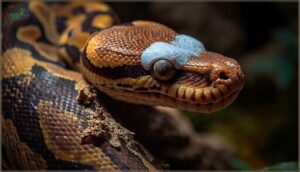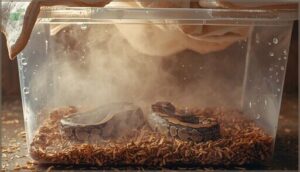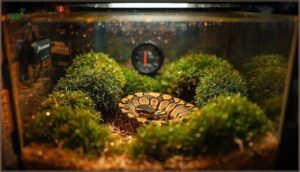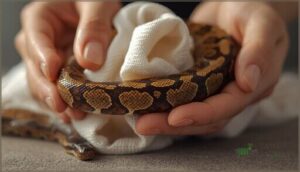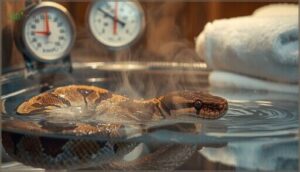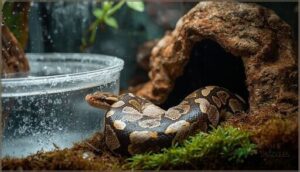This site is supported by our readers. We may earn a commission, at no cost to you, if you purchase through links.
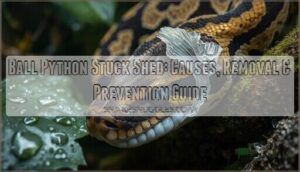
Your ball python’s eyes cloud over, signaling the start of a shed cycle. A week passes, and patches of dull skin still cling to the body, refusing to peel away.
This incomplete shedding isn’t just cosmetic—it can lead to infection, vision problems, and even tissue death if the constricted skin cuts off circulation to the tail tip. Stuck shed happens when something in your python’s environment disrupts the natural shedding process, usually related to humidity levels, hydration, or underlying health concerns.
The good news is that most cases are preventable with proper husbandry, and when stuck shed does occur, you can address it safely at home using techniques that work with your snake’s biology rather than against it.
Table Of Contents
- Key Takeaways
- Causes of Stuck Shed in Ball Pythons
- Recognizing Stuck Shed Problems
- Safe Methods to Remove Stuck Shed
- Preventing Stuck Shed in Ball Pythons
- When to Seek Veterinary Assistance
- Frequently Asked Questions (FAQs)
- How to keep a ball python from shedding?
- Why is my ball python shedding too often?
- How long does ball python shedding take?
- Why does my ball python have a retained eye cap?
- How do you hydrate a ball python?
- How do you remove a retained eye cap from a ball python?
- What to do if your ball python has stuck shed?
- Can a stuck shed hurt a snake?
- How to help a snake with an incomplete shed?
- What causes a stuck shed?
- Conclusion
Key Takeaways
- Stuck shed in ball pythons primarily results from humidity below 60% and inadequate hydration, which prevents the old skin from releasing properly and can lead to infection, vision problems, or tissue death if untreated.
- The safest removal methods include using a “snake sauna” (humid container with warm water and substrate for 15-20 minutes) or providing a humidity box with damp sphagnum moss, while avoiding forced soaking that can cause stress and respiratory issues.
- Prevention requires maintaining 60-80% ambient humidity with digital monitoring, providing constant access to fresh water, offering moist hides during shedding, and avoiding all handling from the moment eyes cloud until the shed completes.
- Veterinary intervention becomes necessary when you observe signs of scale rot (darkened belly scales, blister formation), persistent stuck shed across multiple cycles despite proper humidity, severe dehydration symptoms, or retained eye caps that don’t resolve within one week.
Causes of Stuck Shed in Ball Pythons
Stuck shed doesn’t happen without a reason—it’s your snake’s way of telling you something’s off in their environment or health. Most cases trace back to a handful of fixable husbandry issues that prevent the skin from releasing properly.
Let’s look at the main culprits behind incomplete sheds in ball pythons.
Low Humidity Levels
When humidity levels drop below 60%, your ball python’s skin dries out, making retained shed almost inevitable. Inadequate enclosure humidity prevents the old skin from loosening properly, leading to patches stuck around the eyes, tail, and body. Low humidity also contributes to respiratory issues and dehydration, compounding shedding problems.
You’ll need a digital hygrometer to monitor humidity daily and maintain levels around 70-80% during shed cycles. A proper enclosure should also consider secure and locked enclosures to prevent escape.
Dehydration and Water Availability
Your ball python needs constant access to fresh water, with bowl placement and daily monitoring of water availability critical to preventing dehydration. Most pythons drink every few days, but frequency increases during shedding.
Watch for hydration signs like wrinkled skin or sunken eyes—these indicate serious problems. A water dish large enough for soaking helps, and electrolyte baths can restore hydration and proper shedding within just one or two treatments when dehydration strikes.
Recognizing loss of skin elasticity can also be an early indicator of dehydration.
Improper Enclosure Setup
Even with plenty of water, your python’s enclosure conditions directly determine whether it sheds cleanly. Substrate depth under four inches won’t hold moisture, and poor ventilation needs create swings in enclosure humidity that stress your snake.
Temperature gradient problems—like heating elements placed too close—dry out local zones, while enclosures lacking enrichment items like rough branches remove the abrasive surfaces your python needs to rub off old skin.
Health Issues Affecting Shedding
Beyond setup missteps, underlying health problems sabotage your snake’s shed cycle. Respiratory infections disrupt normal shedding in a quarter of clinical cases, while parasitic infestations like mites irritate skin and cause incomplete removal around eyes and tail.
Nutritional deficiencies weaken skin integrity, and bacterial skin infections involving Pseudomonas species complicate retained shed.
Endocrine disorders can accelerate shedding frequency, increasing hydration issues and failure rates.
Recognizing Stuck Shed Problems
Spotting stuck shed early makes a real difference in keeping your ball python healthy. You’ll want to check a few key areas where old skin usually hangs on, like the eyes, tail, and body.
Here’s what to look for during and after your snake’s shedding cycle.
Retained Eye Caps
One of the most overlooked signs of a stuck shed is retained eye caps, also called spectacle opacity. When humidity drops below ideal levels, the clear scale covering your ball python’s eye won’t shed properly, leading to cloudiness, vision impairment, and infection risks.
Check every shed to confirm both eye caps came off. If cloudiness persists beyond one week, manual removal by a veterinarian may be needed to prevent permanent damage.
Patches of Old Skin
After a shed, inspect your ball python carefully for patches of retained shed—rough, dull areas that feel like sandpaper, often appearing on the midsection or around the eyes.
These patches signal humidity levels below the 60-70% range your snake needs. Identifying patches early prevents complications, as stuck shed can persist for multiple shedding cycles if left untreated, increasing infection risks and requiring repeated treatment efforts.
Tail Tip Constriction
At the very tip of your ball python’s tail, stuck shed wraps tight like a rubber band, cutting off blood circulation to the delicate tissue below. This creates a real amputation risk if you don’t catch it early.
Stuck shed at a ball python’s tail tip can constrict like a tourniquet, creating a real risk of tissue death and amputation
Watch for these warning signs:
- Darkened or discolored tail tip indicating tissue necrosis
- Visible constriction rings from retained shed accumulation
- Scale damage or swelling near the affected area
Monitoring progress daily and infection prevention through prompt removal protects your snake from losing the tail tip entirely.
Signs of Discomfort or Stress
Your ball python’s behavior tells you when stuck shed is causing real trouble. Restless behavior like excessive rubbing, increased cage exploration, or constant attempts to escape signals discomfort.
You’ll notice appetite changes—most snakes refuse food during problematic sheds. Opaque eyes that stay clouded, skin dullness that persists, and defensive behavior like hissing or striking all point to snake stress requiring immediate attention to prevent worsening ball python shedding issues.
Safe Methods to Remove Stuck Shed
When your ball python has stuck shed, you need to act carefully to avoid causing stress or injury. The right approach raises humidity around the skin without forcing anything off or putting your snake in harm’s way.
Here are the safest methods to help your ball python complete its shed.
Snake Sauna Technique
The Snake Sauna is your best alternative to stressful soaking when treating stuck shed. You’ll need a storage bin with a secure lid, warm water at 90-95°F, and coco husk chips to hold moisture.
Place your ball python inside, cover with a towel for security, and let humidity levels work their magic for 15-20 minutes while your snake naturally rubs off loosened skin.
Using Humidity Boxes
A humidity chamber offers a safer, ongoing solution for stuck shed. Line a hide box with damp sphagnum moss or moisture-retaining substrate like coconut fiber, keeping it moist but not soaking wet to prevent scale rot. Position this box in your enclosure’s warm zone and monitor humidity levels with a digital hygrometer.
Your ball python can enter whenever it needs extra moisture, mimicking natural humid burrows without forcing stressful interactions.
Gentle Manual Assistance
When humidity interventions don’t resolve localized shed on tail tips or eye caps, you can offer gentle manual assistance—but only as a last resort. Manual removal risks scale damage if rushed, so prepare by dampening a soft cloth with warm water and a tiny amount of coconut oil or vegetable oil. Work during low-stress conditions to avoid overwhelming your ball python:
- Limit sessions to 2-3 minutes maximum
- Never pull stuck shed with force
- Support the body gently while working
- Focus only on isolated patches
- Monitor for redness or injury afterward
Most experienced keepers report success rates above 75% when using damp paper towels on stubborn areas, with skin damage occurring in fewer than 2% of cases. If your snake becomes head-shy or defensive—common reactions during eye work—stop immediately. Post-removal care includes watching for signs of irritation and maintaining ideal humidity to support healing.
Soaking Risks and Precautions
While manual removal helps, soaking carries real risks if you’re not careful. Water temperature must stay between 80–85°F—anything colder invites hypothermia and infection prevention becomes harder. Soaking duration shouldn’t exceed 15–20 minutes; longer sessions risk respiratory distress and scale rot from skin maceration.
Stress reduction matters too: ball pythons aren’t aquatic, so forced soaking triggers defensive behaviors in most individuals. Post-soak care includes thorough drying and monitoring for complications.
When treating stuck shed, always prioritize veterinary advice for reptiles over repeated soaking cycles, which can worsen dehydration and create new health problems.
Preventing Stuck Shed in Ball Pythons
Prevention is always easier than treatment when dealing with stuck shed. You can avoid most shedding problems by creating the right environment and following a few simple care practices.
Let’s look at the key steps that keep your ball python shedding smoothly every time.
Maintaining Proper Humidity
To keep your ball python healthy, you’ll need to maintain ambient humidity between 60-80% consistently. Digital hygrometers placed throughout the enclosure help you monitor these critical levels accurately.
Here are effective methods for maintaining proper humidity:
- Use substrate like coconut fiber that holds moisture when lightly watered
- Mist the enclosure once or twice daily, avoiding excessive dampness
- Add a reptile humidifier in drier climates to stabilize humidity levels
Providing Moist Hides
A dedicated moist hide gives your ball python a refuge with 70-80% humidity during shedding. Use a plastic container with an entrance hole, fill it with damp sphagnum moss or coconut fiber substrate, and place it on the warm side.
Check daily that the substrate stays moist but not soaking wet. This simple hide construction dramatically reduces stuck shed and retained eye caps.
Ensuring Adequate Hydration
Your ball python won’t shed cleanly without consistent access to fresh water. Check water levels daily and refill immediately when low, since these snakes drink sporadically, often at night.
- Place a stable water bowl large enough for soaking on the cool side
- Monitor humidity with a digital hygrometer, maintaining 60-80% ambient levels
- Choose water-holding substrate like coconut fiber to support steady hydration
Proper humidity monitoring and water availability prevent 70% of stuck shed cases.
Reducing Handling During Shed
Frequently, snake stress peaks during shedding because their cloudy eye caps impair vision, making them defensive. Skip all non-essential handling from the moment you notice cloudiness until your ball python completes the shed.
Minimal handling benefits their natural shedding behavior and reduces incomplete sheds. This ethical consideration respects their physiological needs, conserves energy, and prevents oils from your hands from disrupting their skin’s natural separation process.
When to Seek Veterinary Assistance
Most stuck shed issues resolve with proper humidity and gentle care at home, but sometimes you need a professional’s help.
Knowing when to call your vet can prevent minor problems from becoming serious health concerns. Watch for these warning signs that indicate it’s time to schedule an appointment.
Signs of Infection or Scale Rot
When stuck shed goes wrong, scale rot can develop quickly. Watch your ball python closely for these veterinary indicators:
- Scale discoloration – darkened belly scales appear in 73% of confirmed infections, signaling early trouble
- Blister formation – clear fluid-filled bumps emerge beneath scales in 80% of later cases
- Behavioral changes – reduced appetite affects 55% of infected snakes as their bodies fight infection
- Environmental links – excessive moisture causes 81% of outbreaks, making husbandry assessment critical
Contact your reptile health veterinarian immediately if you spot these signs.
Persistent Stuck Shed Issues
When your ball python experiences recurrent episodes despite proper humidity adjustments, it’s time for vet intervention.
Chronic humidity issues below 60% cause over 80% of persistent cases, and retained shed across multiple cycles leads to shed complications like eye caps and tail constriction in 30–40% of snakes.
Without treatment, secondary infections develop in 15% of prolonged cases, making professional help essential for resolving ball python shedding issues safely.
Behavioral or Health Changes
When your ball python suddenly stops eating, hides constantly, or strikes more often than usual, these behavioral shifts are red flags. Lethargy signs and appetite changes appear in 37–39% of stuck shed cases, while defensive behavior increases by 17%.
Visual impairment from retained eye caps reduces foraging ability by 21%, and weight decrease averages 12% in chronic cases.
These snake stress markers demand veterinary advice for reptiles promptly.
Addressing Severe Dehydration
When your ball python shows severe dehydration—wrinkled skin, sunken eyes, or extreme lethargy—veterinary interventions become critical. Your vet may administer fluid therapy using subcutaneous or intravenous solutions, with dehydration risks including organ failure if untreated.
Treatment outcomes improve dramatically with prompt care:
- Electrolyte soaks (30–60 minutes at 27–28°C) support rehydration
- Fluid therapy restores hydration within 12–24 hours
- Preventative care through proper humidity and hydration stops recurrence
Snake health depends on catching these signs early and seeking veterinary advice for reptiles immediately, preventing shedding problems before they escalate.
Frequently Asked Questions (FAQs)
How to keep a ball python from shedding?
You can’t stop the snake shedding process—it’s natural as your ball python grows.
Instead, focus on preventing stuck shed by increasing enclosure humidity, providing rough surfaces, and monitoring water availability consistently.
Why is my ball python shedding too often?
Young ball pythons shed every 3-4 weeks due to their rapid growth rate. However, excessive shedding in adults may indicate underlying issues such as mite infestation, nutritional imbalance, environmental stress, or genetic factors.
Monitor your snake’s health closely and adjust care accordingly to address any potential problems.
How long does ball python shedding take?
Ball python shedding usually takes 7 to 14 days from start to finish.
Juvenile shedding frequency is higher due to growth, while environmental impact and proper humidity directly influence shedding duration and post-shedding recovery success.
Why does my ball python have a retained eye cap?
Seeing through the problem isn’t always easy—retained eye caps happen when humidity drops below 50%, dehydration sets in, or your enclosure design flaws prevent proper rubbing.
These shedding problems signal stuck shed, requiring veterinary intervention to protect snake health.
How do you hydrate a ball python?
You hydrate your ball python through three key methods: providing fresh water daily in an appropriately sized bowl, maintaining enclosure humidity between 60-80%, and offering optional soaks in shallow, lukewarm water during shedding cycles.
How do you remove a retained eye cap from a ball python?
To remove a retained eye cap, soak your snake in lukewarm water for 15–30 minutes, then gently use a wet cotton swab at the edge. If it doesn’t lift easily, consult a veterinarian.
What to do if your ball python has stuck shed?
When treating stuck shed, try a snake sauna first—it’s a safer alternative to soaks in lukewarm water.
Monitor progress closely, then consider gentle manual removal or other shedding aids if needed for proper snake care.
Can a stuck shed hurt a snake?
Yes, stuck shed can seriously harm your snake. Retained shed causes tissue damage and increases infection risks by up to 4 times. It often signals dehydration effects that require treating stuck shed promptly to protect snake health.
How to help a snake with an incomplete shed?
When your snake struggles with an incomplete shed, boost enclosure humidity to 70-90%, offer moist hides, and use a snake sauna alternative.
These steps support natural shedding frequency and prevent stuck shed without risky soaking.
What causes a stuck shed?
Low humidity is the primary culprit behind retained shed in ball pythons. Dehydration, poor enclosure conditions, inadequate water access, and health issues also contribute.
Maintaining proper enclosure humidity prevents stuck shed problems effectively.
Conclusion
A single retained eye cap can seem minor until it leads to infection; a small patch of stuck skin around the tail can cut off circulation in hours. These aren’t hypothetical risks—they’re preventable realities.
Ball python stuck shed responds well to proper humidity, adequate hydration, and timely intervention when problems arise. You now have the tools to recognize the warning signs, address them safely, and adjust your husbandry to prevent recurrence. Your python’s health depends on it.
- https://reptifiles.com/ball-python-care-guide/ball-python-diseases-health/ball-python-shedding/
- https://community.morphmarket.com/t/husbandry-shed-questions/40920
- https://www.reddit.com/r/snakes/comments/breke8/ball_python_stuck_shed_help/
- https://www.facebook.com/groups/967708664967231/posts/1121005326304230/
- https://wheremyscalesslither.weebly.com/stuck-shed.html

